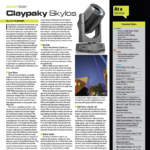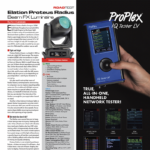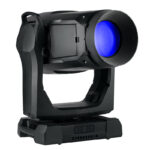Harman’s lighting division, Martin Professional, has long been the innovator of new light technology, especially along the LED line. Following in the footsteps of their MAC Aura series, they have introduced The MAC Quantum Wash. Rather than concentrate solely on the LED eye candy trend, Martin committed themselves to a fresh new concept — using an LED source to create a stunningly bright, pure white light beam.
Most companies manufacture LED fixtures that can mix off-white colors. The usual pink or blue hues associated with those fixtures’ so-called white output have been a thorn in designers’ sides for the last decade. Any RGBW LED fixture can be manipulated so only the white LEDs in the fixture come on. But in that state, the fixture loses brightness and the white color appears weaker in lumens compared to the saturated colors. With the Quantum Wash, Martin touts a revolutionary “Colorganics” system, using all the colored LEDs in the fixture to mix a powerful 6500K daylight beam.
Larger and Brighter
The first thing I notice is that this fixture is larger and brighter than its predecessor. Martin wanted the first LED fixture that can emulate the beam of a new discharge lamp. This fixture appears to be as bright as the standard MAC 2K wash light when I add some color in the beam. The Quantum Wash boasts 750 watts of power. I have the fixture plugged into a 110V wall outlet and, when at full, the amp meter shows that a single fixture draws 7.5 amps. The fixture defaults all RGBW internal LEDs to full to show this white beam. With the zoom set at the minimum of 11 degrees, I stand 20 feet away with my meter, measuring illumination at 1350 lux. The beam appears in a perfectly collimated shape. I widen the zoom halfway towards its full 55 degree width and meter the light output again. It has lost about 25 percent of its brightness and, of course, the field isn’t as flat as it was. But I still measure an impressive 1000 lux at the same distance. This fixture would obviously make a good cyc light as well as a rock ‘n’ roll narrow-beam fixture.
The head is twice as large as the standard ones on the market these days. It weighs in at 46 pounds, but that’s less than an old MAC 600 discharge wash light. There are a total of 50 of these quad color LED modules mounted in the front face of the light. Covering as well as protecting these cells is a new lens. This lens is made up of clear bubbles mounted to a Fresnel-looking flat glass, very similar to the MAC Aura. But it’s taken the usual zoom lens to the next level. It slides forward and backwards on a rod, adjusting the zoom of the fixture. I can spread the beam width from zero to full in half a second. That’s fast enough for any quick effects I need. But the same rod that holds the lens in place can now spin at variable speed. One needs to only view this for a second to realize that this fixture is ready to exceed expectations as far as potential eye candy effects.
Eye Candy Effects
The fixture can be run in a basic 14-channel mode, but I go with the extended 33-channel mode to get the full experience. I notice that the fixture has its intensity and beam colors spread over three separate groups. The Quantum Wash is designed to be able to chase or fade between three rings of LEDs on the fixture. For instance, the outside perimeter of this light consists of 20 separate LED cells. Each uses RGBW internal LEDs to mix and emit the same color all the time. There is a middle ring of another 16 cells, followed by a separate center cluster of 14. One can run a three-step chase of intensity through one fixture and notice the beam size change as one set pops on and another goes off. I run a sin-wave intensity effect, and it looks like waves of light pulsing out of the fixture. The same applies with the color effects. Red, White and Blue beams are easily chased. Placing a red outer layer around a center cluster of yellow emits a pleasing light effect, especially if I leave the middle ring off. I then put the middle ring in a blue color and chase the intensity between the two groups of LEDs in different colors. At a fast rate, cool colored strobing effects are emitted. The EDM crowd will eat these up.
While scrolling through color values, I notice I have no control over the white values when mixing colors. I am running the fixture using only three wheels to mix Cyan, Magenta and Yellow, yet I know there is a White LED as well. Martin chose to reinvent their color mixing system to make it easier on the programmers. One can use the typical color picker on any lighting console and find that true electric blue or rich golden amber color that is often hard to mix on other LED fixtures. And the color picker utilizes the white LEDs by itself. I can mix almost all the colors in the spectrum except deep lavender and blue green — two hard-to-mix, saturated color hues that cannot be achieved here. This light can easily clone into any other LED or discharge fixture with color mixing now — a great advantage to any production facing the challenge of utilizing different lights dependent on venue.
I then notice that the Quantum Wash has brought back one of the lovely effects of the Aura — the ability to backlight the entire Fresnel lens in front of the fixture. One can turn the face of the fixture to any color the separate RGB pixels can mix it, but the fixture doesn’t actually emit much light at all. It’s just eye candy. But the effect of having a red light in some scenery be on, then random white bursts of strobing light through the opening, is still a dazzling effect, and I’m glad they kept it.
Camera Ready
I see that there is also a CTO wheel function to add color correction on top of the colors for camera use. The fixture profile I am using actually shows the physical stops for various degrees, such as 2400K or 3200K, taking the guesswork (and the meter) out of the task.
I go to test out the pan and tilt on the fixture for accuracy. First of all, I let the light confuse me by thinking it would have to move slower than most LED fixtures because of its size. Nope, it actually moved just as fast. I have it sitting side-by-side with a MAC Aura, and it beats it by 20 percent in pan and tilt speed. I can pan the light 180 degrees in half a second. Not lightning quick, but fast enough to black out and reset a light in another position. The fixture comes with standard sync and random strobe speeds. The company is still working on pulse effects as well as a lot of macros to easily make eye candy effects without tons of programming.
Beyond Eye Candy
Designers can use the 50 quad color LED modules Martin’s MAC Quantum Wash fixture for eye candy effects, including the three concentric rings of LED modules and the Aura’s ability to backlight the entire lens in front of the fixture. But this fixture would also work well as a cyc light, or as a rock ‘n’ roll narrow-beam fixture. And it moves quickly.
Specs and Features
Size: 17.8” x 17.8” x 21.5”
Weight: 46 lbs.
Light Source: 50 15W LEDs
Lamp Life: 50,000 hours
Color Mixing: RGBW LEDs
Total Output: 15,400 lm
Max Power Consumption: 760W
Color Wheel: 36 Lee-referenced colors
Zoom: 11 to 59 degrees
Certifications: EU EMC, UL, CSA, C-Tick
Martin MAC Quantum Wash
Pros: LED fixture that can emulate a pure white discharge lamps output; revolutionary color-mixing system; dazzling effects; fast movement
Cons: A few hues remain hard to mix
MSRP: $9,998



